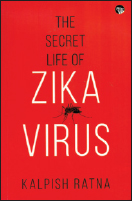Translate this page into:
The Secret Life of Zika Virus
Corresponding Author:
Reeta S Mani
Department of Neurovirology National, Institute of Mental Health and Neurosciences, Bengaluru, Karnataka
India
drreeta@gmail.com
| How to cite this article: Mani RS. The Secret Life of Zika Virus. Natl Med J India 2017;30:361 |
Kalpish Ratna. Speaking Tiger Publishing Pvt. Ltd, New Delhi, 2017. 271 pp, ₹299. ISBN 978–93–86582–42–3.

A virus, seemingly quiescent since its serendipitous discovery in the Zika forest of Uganda, way back in 1947, took the world by surprise in its recent, terrifying avatar. By late 2015, doctors in Brazil observed a surge in babies with microcephaly—an abnormally small head, indicating that their brains had failed to develop properly. They could link this disastrous abnormality in the babies to Zika virus infection in the mothers during pregnancy. How had the Zika virus, known to cause just a self-limiting fever and rash until then, suddenly turned so vicious?
News of three confirmed cases of Zika virus infection in Gujarat, in May 2017, shook us out of our complacency in India and made us scamper for more information on this virus. Dearth of dependable, scientific statistics and a surplus of confusing and conflicting information only added to our hysteria.
Kalpish Ratna, a pseudonym used by the surgeon duo—Tshrat Syed and Kalpana Swaminathan, has come to our rescue by aspiring to cut through the din of misinformation and exhume scientific clues to satiate our curiosity in this timely and comprehensive biography of the Zika virus.
To one of the authors, all the information currently available about Zika virus appears much like the jumble in her dad's kaleidoscope kit she saw as a child: ‘the more T read of glittering new discoveries, the more fragmented they seem. ‘However, for science to make sense, the author delightfully fathoms: ‘These glittering pixels must emerge, shift and settle, before they assemble into the aesthetic perfection we instinctively recognize as truth.’
Beginning logically, with what exactly a virus is—for the uninitiated—and how every virus came from a virus (Omnis virus e virus), how viruses evolved to coexist with us, to the spectacular beauty of the Zika virus symmetry—‘D.H. Lawrence could easily have been speaking about a virus, not a geranium’ (pleasing the virologist in me enormously!), the authors trace the Zika virus's vector of choice—the Aedes aegypti mosquito, through several continents. The interesting origin of the name (albeit a misnomer) of the mosquito (‘by its capacity to annoy! ’); all viral passengers likely on board the Aedes aegypti—yellow fever, dengue, chikungunya, Zika; the sumptuous blood meal of the elegant Lady Aedes and her swift mid-flight mating with Monsieur Aedes, followed by ‘the most momentous act of her existence, oviposition,’ makes for a delightful read, even for those who love to hate these ‘winged vampires’ (which is obviously every one of us!).
The book explores the basis for the emergence of Zika virus infections in Brazil and its association with the widespread destruction of the rain forests. ‘Aedes aegypti is a tree hole dweller. Cut down a tree, and the evicted mosquito will move in right with you.’ The authors also contemplate the likelihood of another, yet unknown, mosquito vector responsible for the spread of Zika virus.
The authors methodically proceed to delve into the history of several countries across continents—by the voyages of Columbus, through raging fevers and rashes, dissected corpses and swollen livers, nauseating odours and scrupulous scribbles of doctors, and through head moulding traditions and distorted skulls … trying to track if Zika virus could have been present much before its ‘discovery’ by way of its foot-prints on the sands of time.
The authors also provide a succinct overview of the most recent scientific research in this field—including the phylogenetic analysis of the viral strains, the mechanisms of vertical transmission and foetal neurotropism.
The authors believe, justly so, that ‘the innate selfishness of our species underpins the emergence of disease.’ They conclude the book on a cautionary note; the Zika phenomenon should be a wake-up call for humankind.
This book, a culmination of a diligently researched theme by the authors, is lucid and informative, and makes for an enjoyable read for doctors, scientists, students of medicine and allied fields, and to any other inquisitive reader alike. The authors, known for their distinctive narrative flair, make a sincere and mostly successful attempt to simplify complex scientific jargon, yet certain parts of the book may be a bit too technical to assimilate for some readers.
There has been an explosion of published literature on various aspects of Zika virus infection, even after this book was published (in mid-2017) and will likely continue unabated. Yet, this first comprehensive red book on The secret life of Zika virus is worthy of retaining its respectable place on our bookshelves for several years to come.
Fulltext Views
1,230
PDF downloads
868




